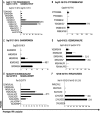The major histocompatibility complex class II alleles Mamu-DRB1*1003 and -DRB1*0306 are enriched in a cohort of simian immunodeficiency virus-infected rhesus macaque elite controllers
- PMID: 17989178
- PMCID: PMC2224575
- DOI: 10.1128/JVI.01816-07
The major histocompatibility complex class II alleles Mamu-DRB1*1003 and -DRB1*0306 are enriched in a cohort of simian immunodeficiency virus-infected rhesus macaque elite controllers
Abstract
The role of CD4(+) T cells in the control of human immunodeficiency virus (HIV) and simian immunodeficiency virus (SIV) replication is not well understood. Even though strong HIV- and SIV-specific CD4(+) T-cell responses have been detected in individuals that control viral replication, major histocompatibility complex class II (MHC-II) molecules have not been definitively linked with slow disease progression. In a cohort of 196 SIVmac239-infected Indian rhesus macaques, a group of macaques controlled viral replication to less than 1,000 viral RNA copies/ml. These elite controllers (ECs) mounted a broad SIV-specific CD4(+) T-cell response. Here, we describe five macaque MHC-II alleles (Mamu-DRB*w606, -DRB*w2104, -DRB1*0306, -DRB1*1003, and -DPB1*06) that restricted six SIV-specific CD4(+) T-cell epitopes in ECs and report the first association between specific MHC-II alleles and elite control. Interestingly, the macaque MHC-II alleles, Mamu-DRB1*1003 and -DRB1*0306, were enriched in this EC group (P values of 0.02 and 0.05, respectively). Additionally, Mamu-B*17-positive SIV-infected rhesus macaques that also expressed these two MHC-II alleles had significantly lower viral loads than Mamu-B*17-positive animals that did not express Mamu-DRB1*1003 and -DRB1*0306 (P value of <0.0001). The study of MHC-II alleles in macaques that control viral replication could improve our understanding of the role of CD4(+) T cells in suppressing HIV/SIV replication and further our understanding of HIV vaccine design.
Figures



References
-
- Altfeld, M., and E. S. Rosenberg. 2000. The role of CD4(+) T helper cells in the cytotoxic T lymphocyte response to HIV-1. Curr. Opin. Immunol. 12375-380. - PubMed
-
- Bevan, M. J. 2004. Helping the CD8(+) T-cell response. Nat. Rev. Immunol. 4595-602. - PubMed
-
- Brenchley, J. M., T. W. Schacker, L. E. Ruff, D. A. Price, J. H. Taylor, G. J. Beilman, P. L. Nguyen, A. Khoruts, M. Larson, A. T. Haase, and D. C. Douek. 2004. CD4+ T cell depletion during all stages of HIV disease occurs predominantly in the gastrointestinal tract. J. Exp. Med. 200749-759. - PMC - PubMed
-
- Calman, A. F., and B. M. Peterlin. 1987. Mutant human B cell lines deficient in class II major histocompatibility complex transcription. J. Immunol. 1392489-2495. - PubMed
Publication types
MeSH terms
Substances
Grants and funding
- R01 AI052056/AI/NIAID NIH HHS/United States
- RR020141-01/RR/NCRR NIH HHS/United States
- R01-AI049120/AI/NIAID NIH HHS/United States
- R24 RR016038/RR/NCRR NIH HHS/United States
- R01-AI052056/AI/NIAID NIH HHS/United States
- R24 RR015371/RR/NCRR NIH HHS/United States
- N01 CO012400/CA/NCI NIH HHS/United States
- P51-RR000167/RR/NCRR NIH HHS/United States
- N01-CO-12400/CO/NCI NIH HHS/United States
- C06 RR020141/RR/NCRR NIH HHS/United States
- C06 RR015459/RR/NCRR NIH HHS/United States
- P51 RR000167/RR/NCRR NIH HHS/United States
- RR15459-01/RR/NCRR NIH HHS/United States
- R01 AI049120/AI/NIAID NIH HHS/United States
- ImNIH/Intramural NIH HHS/United States
- R24-RR015371/RR/NCRR NIH HHS/United States
- R24-RR016038/RR/NCRR NIH HHS/United States
LinkOut - more resources
Full Text Sources
Other Literature Sources
Research Materials

